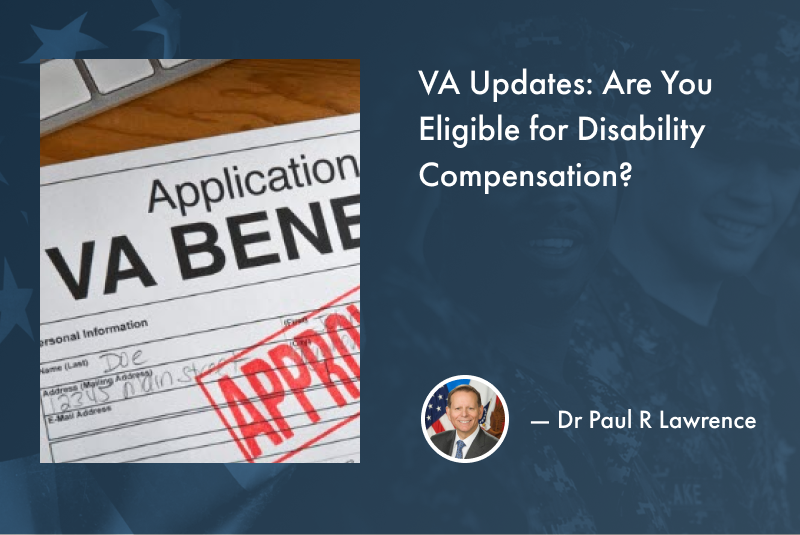A frequent topic in conversations with Veterans is how they were injured in service and whether they are eligible for benefits. Generally, they point out they didn’t serve in combat but were injured while in service. Their question is, given their experience, “Am I Eligible for Disability Compensation?”
Eligibility Criteria for Disability Compensation
The specific benefit they are referring to is Disability Compensation. This is a tax-free monthly payment for Veterans who have suffered an injury or disability while in service. Consequently, under certain conditions, the answer to the question could be yes. One important requirement is to demonstrate that the injury is connected to service, often called Service Connection.
Service-Connection can be demonstrated in one of three ways:
1. Direct Service-Connection
2. Aggravated Service-Connection
3. Secondary Service-Connection
Types of Service-Connection for Disability Compensation
Direct Service-Connection
This means that the injury occurred while in service. The phrase “while in service” is critical as it doesn’t limit when the injury occurred to a specific location or event. Your injury could have occurred in combat, training, doing routine duties, or even during time away from official duties.
To demonstrate a Direct Service Connection, you need to show:
• The injury occurred while in service
• The injury still exists – that is, it’s current
• A link (or nexus) between what happened in service and your current situation
An example – Service member Jane Smith falls off a ladder while painting the barracks, hurting her back. Years later when she files for Disability Compensation due to continued issues with her back, she points out the injury was directly related to her time in service.

Aggravated Service-Connection
This means that a condition that existed upon entering service was made worse while in service. A key here is that the worsening must be greater than what would have happened naturally over time. Accurate medical records documenting the condition when beginning service are very important.
An example: Robert had a skin condition prior to entering military service. Due to exposure to certain chemicals in the military, Robert’s skin condition became worse than it would have been on its own through natural progression. When filing for Disability Compensation, Robert demonstrates that his condition was aggravated while in service.

Secondary Service-Connection
This means another service-connected injury caused the condition. When this happens, the newer injury, which is near or close to the previously service-connected injury, is considered to be service-connected. The second injury does not need to be related to military service and often happens later, in many cases years later.
One way to think about Secondary Service-Connection is the second injury would not have occurred were it not for the first, service-connected injury. To demonstrate this, you must show causation – that is, the secondary condition was caused by the service-connected disability.
An example – Pat severely hurts his ankle while in service, and it’s service-connected. Later, he develops problems with his knee on the same leg. While filing for Disability Compensation for his knee, Pat demonstrates it was caused by his service-connected ankle injury.

Get Assistance with Disability Compensation from a VA
This can be confusing, and applying for Disability Compensation can be tedious, but don’t be discouraged. You can get no-cost assistance from a Veteran Service Officer, who can help develop and file your claim. Service Officers have been trained in VA processes. Look for one who is “Accredited” by the U.S. Department of Veterans Affairs, indicating they keep up to date with training and have passed a background screen.
Service Officers are available from:
• The American Legion
• Disabled American Veterans (DAV)
• Paralyzed Veterans of America (PVA)
• Veterans of Foreign Wars (VFW)
• Wounded Warrior Project
You can also access a Service Officer from your state Department of Veteran Affairs/Services. Some counties also provide Service Officers. A quick internet search should allow you to find one or both of these near you.
About the Author Paul R. Lawrence
Paul R. Lawrence, Ph.D., served as Under Secretary of Benefits at the U.S. Department of Veterans Affairs from May 2018 to January 2021. He is the author of “Veterans Benefits for You: Get what You Deserve,” available from Amazon.

Read About Other VA Updates
If you enjoyed reading the article “Are You Eligible for Disability Compensation?”, we invite you to read the stories of VA Updates on our blog. In addition to our profiles of celebrities who served, we share military book reviews, veterans’ service reflections, famous military units and more on the TogetherWeServed.com blog. If you are a veteran, find your military buddies, view historic boot camp photos, build a printable military service plaque, and more on TogetherWeServed.com today.
.

0 Comments